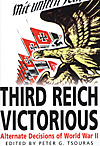 Greenhill, 2002, $18.95, ISBN 1-85367-492-3, 256 pgs., hardback
Greenhill, 2002, $18.95, ISBN 1-85367-492-3, 256 pgs., hardback
I, for one, find a US win and a Nazi loss in WWII not only perfectly acceptable, but preferable to the reverse. In wars of ideology, I am behind Winston Churchill's oft-quoted remark that democracy is the worst political system--except for all the others. That doesn't diminish the efforts by the armed forces on both sides. German troops fought honorably for their country, too, with the exceptions of Einsatztrupper, SS at Malmedy, concentration camp guards and other similar murderers. And though the US fought Germany twice in the first half of the 20th century, the country has been a close ally for the last half century.
So no, I don't wish to see the Third Reich victorious.
However, from an intellectual standpoint, I find mental "what-ifs" throughout history to be fascinating. It's one reason why so many examine military history in a variety of products --computer wargames, board war games, historical miniatures and so on. And though we take a US victory as a certainty, back in WWII, victory was not such a sure thing. This book offers 10 scenarios for German victory in various stages of the war.
Some of them are quite cleverly composed.
The Storm and the Whirlwind, by Gilberto Villahermosa, is one of the best. It assumes, with some historic validity, that Stalin decided to accept Zhukov's suggestion and strike the Nazis first in 1941 instead of waiting. It also assumes that Hitler postponed to actual attack on the USSR because his staff advised him to wait as the Soviets were massing for the attack. In the campaign, the Soviets plunge into Poland, only to be encircled, crushed, and counterattacked. Rommel driving through the Pripyet Marshes is an especially nice touch.
The Little Admiral posits that Hitler fell in with a chief petty officer prior to WWI, who convinced him to join the Navy instead of the Army. Hitler comes away from WWI with a naval viewpoint and concentrates his efforts at building a four-carrier German Navy and strong U-boat force. This delivers a pearl Harbor-style attack to open WWII and from then on, it's a German ocean. The only jarring nit to pick is when Hitler, a U-boat officer in WWI, throws himself in between an engine piston and hull to save his ship. I'm checking with the U-boat experts at Sharkhunters for their opinion of this, er, heroism. It seems to me that if a loose piston would punch through a steel hull, it would punch through Hitler's head, too.
I enjoyed the entry of Turkey on the Axis side and the resulting exploits in the Caucuses. I was not so enthralled with Rommel breaking El Alamein and taking Baghdad and the oil fields--this is so far-fetched as to be science fiction, not alternative history fiction. Other scenarios were between these two extremes.
All in all, it was a readable what-if book, although it relies on coincidences, much like Rising Sun Victorious. One wonders what would've happened had both volumes occurred--probably a German-Japanese WWIII. Still, the points highlighted are intriguing for a mental exercise, and it does invoke a set of multiple considerations with each scenario.
Back to List of Book Reviews: World War II
Back to Master List of Book Reviews
Back to Master Magazine List
© Copyright 2001 by Coalition Web, Inc.
This article appears in MagWeb (Magazine Web) on the Internet World Wide Web.
Other military history articles and gaming articles are available at http://www.magweb.com